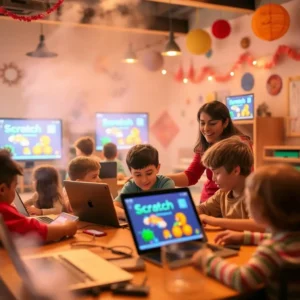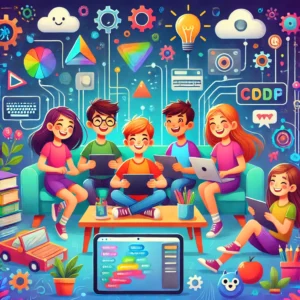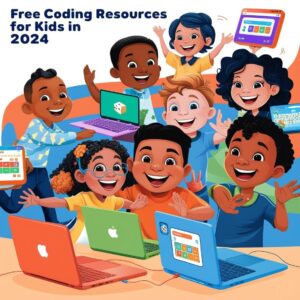In today’s tech-driven world, finding the best coding toys for kids is an excellent way to introduce them to programming and technology. Coding is no longer just a skill for computer scientists—it’s a foundation for problem-solving, creativity, and logical thinking. As technology continues to shape the future, parents are looking for innovative tools to engage their children in coding early on.
One of the most effective ways to make coding approachable is through toys that seamlessly blend play with learning. From building robots to solving interactive puzzles, the best coding toys for kids spark curiosity and provide a fun, hands-on way to learn essential skills.
In this post, we’ll explore top recommendations for coding toys that balance education and entertainment. Along the way, we’ll discuss how to choose the perfect toy for your child, age-specific options, and the lifelong benefits these toys offer in preparing kids for a tech-savvy future.
Let’s dive into how coding toys can transform screen time into skill-building fun and inspire your child’s passion for technology!
Why Coding Toys Are Important for Kids
When it comes to combining fun with learning, coding toys are a game-changer. Not only do they make playtime enjoyable, but they also serve as powerful tools for building essential life skills. By blending technology with hands-on activities, these toys provide an interactive way for kids to explore the world of programming.
1. Developing Problem-Solving Skills
To begin with, coding toys help children tackle problems step by step. For instance, guiding a robot through a maze requires logical thinking and careful planning. Moreover, when things don’t work as expected, kids learn how to troubleshoot and adapt. This process teaches resilience and fosters critical thinking. For additional ways to build problem-solving skills, explore our Ultimate Guide to Free Coding Resources for Kids.
2. Boosting Creativity and Imagination
In addition to problem-solving, coding toys inspire creativity. Imagine your child designing their own game or programming a robot to perform unique tasks. These activities encourage imaginative thinking while demonstrating that coding can be both technical and artistic. Furthermore, tools like storytelling robots seamlessly merge technology with creativity, broadening kids’ perspectives. For more ways to nurture creativity through interactive play, check out our recommendations in The Best Coding Games for Kids in 2024.
3. Preparing for a Tech-Driven Future
Looking ahead, coding toys lay the groundwork for a tech-savvy future. As technology continues to dominate various industries, early exposure to programming concepts gives kids a head start. More importantly, coding toys introduce foundational ideas, like sequencing and algorithms, in an accessible and engaging way. To explore more about the role of technology in shaping young minds, visit our article on Tech Education for Kids.
4. Encouraging Independent Learning
Lastly, many coding toys are designed to promote independent exploration. While playing, kids solve puzzles, build creations, or complete challenges at their own pace. Not only does this build confidence, but it also nurtures a love for self-driven learning.
Ultimately, coding toys bring together fun and education in a way that benefits kids both now and in the future. By introducing these tools, parents can help their children develop essential skills while keeping them engaged and excited about learning.
Top Features to Look for in Coding Toys
Choosing the right coding toy can feel overwhelming, especially with so many options available. However, knowing what to look for can make the decision much easier. Below are the essential features to consider when selecting the best coding toys for kids.
1. Age-Appropriate Design
First and foremost, ensure the toy aligns with your child’s age and skill level. For younger kids, look for toys with simple, intuitive interfaces like drag-and-drop programming. Conversely, older children may benefit from more advanced tools that introduce coding languages like Python or JavaScript. This way, the toy remains engaging and challenging without being frustrating.
2. Educational Value
Of course, the educational aspect is crucial. A great coding toy not only entertains but also teaches valuable STEM concepts. For instance, toys that introduce sequencing, loops, and logic gates provide a solid foundation in programming. Additionally, look for toys that align with school curriculums to reinforce classroom learning.
3. Interactivity and Engagement
Equally important is how interactive the toy is. Coding toys that involve movement, sound, or visual feedback captivate children’s attention longer. Whether it’s a robot that dances when programmed correctly or an app that rewards kids for solving challenges, interactivity keeps the learning process enjoyable.
4. Durability and Safety
Naturally, durability is a must for kids’ toys. Choose coding toys made from high-quality materials that can withstand frequent use. Furthermore, ensure they meet safety standards, particularly for younger children who may still explore by touch or taste.
5. Compatibility with Devices
With technology evolving so quickly, device compatibility is another factor to consider. Some coding toys work best with tablets, while others require computers or smartphones. Before purchasing, check if the toy is compatible with the devices you already own to avoid additional expenses.
6. Expandability
Lastly, consider toys that grow with your child’s skills. For example, some coding kits allow kids to start with basic tasks and gradually progress to more complex projects. This ensures the toy remains useful and engaging over time.
By focusing on these features, parents can make informed decisions and choose coding toys that perfectly balance fun and education.
Best Coding Toys for Kids: Features, Benefits, and Honest Reviews
Coding toys are a fantastic investment in your child’s future, introducing them to the world of programming while developing critical thinking and creativity. Below, we explore the features, abilities kids will improve, and the pros and cons of some of the best coding toys available, tailored to different age groups.
1. Botley The Coding Robot
Age: 5+
Description:
Botley is a screen-free coding robot designed for young children to learn the basics of programming in a hands-on, interactive way. It comes with coding cards, detachable arms, and obstacle-building pieces to make coding challenges engaging and fun.
Features:
- Screen-free learning: No tablets or smartphones required.
- Object detection: Botley can detect obstacles and move around them.
- 77-piece activity set for creating puzzles and challenges.
- Programmable sequences of up to 120 steps.
Abilities:
- Develops logical thinking and problem-solving skills.
- Introduces basic programming concepts like loops and conditionals.
- Encourages creativity and spatial awareness with hands-on tasks.
Pros and Cons:
- Pros:
- Completely screen-free, ideal for younger kids.
- Durable and easy to use for beginners.
- Comes with a variety of accessories for extended play.
- Cons:
- Limited to basic programming concepts.
- May not hold the interest of older children for long.
Why Parents Love It:
Botley makes coding fun and accessible for young kids while minimizing screen time. Parents appreciate its durability, simplicity, and the creative problem-solving it encourages.
Osmo Coding Starter Kit
Age: 5-10
Description:
The Osmo Coding Starter Kit combines physical coding blocks with interactive digital games to teach kids the basics of programming in a playful, hands-on way. It focuses on developing skills like logical thinking and creativity while keeping kids engaged with fun challenges.
Features:
- Includes 3 games: Coding Awbie, Coding Jam, and Coding Duo.
- Physical coding blocks for tactile learning.
- Works with iPads or Fire tablets.
- Adapts to the child’s skill level with interactive feedback.
Abilities:
- Strengthens logical reasoning and pattern recognition.
- Boosts creativity through music and storytelling.
- Encourages teamwork and problem-solving in multiplayer mode.
Pros and Cons:
- Pros:
- Combines tactile learning with digital interaction.
- Engages kids with fun, educational games.
- Grows with the child’s coding skills.
- Cons:
- Requires an iPad or Fire tablet, which may increase the cost.
- Younger children may need guidance during setup.
Why Parents Love It:
Osmo turns screen time into productive learning, teaching coding concepts in an interactive, engaging way. Parents appreciate its adaptability and the creative opportunities it offers for kids.
3. Wonder Workshop Dash Robot
Age: 6-11
Description:
Dash is a voice-activated, app-controlled robot that teaches coding through play. It can move, dance, sing, and respond to commands, making learning fun and interactive.
Features:
- Voice-activated and app-controlled via tablet or smartphone.
- Can perform tasks like obstacle navigation and dancing.
- Compatible with 5 free coding apps (Blockly, JavaScript, etc.).
- Durable and rechargeable design.
Abilities:
- Encourages hands-on problem-solving.
- Builds coding skills from beginner to intermediate levels.
- Fosters creativity with endless programming possibilities.
Pros and Cons:
- Pros:
- Highly interactive and engaging.
- Offers a variety of activities to suit different skill levels.
- Durable and built to last.
- Cons:
- Requires a tablet or smartphone for operation.
- Higher price point compared to simpler toys.
Why Parents Love It:
Dash grows with your child, offering endless opportunities for learning and play. Parents love its interactive features and the way it builds problem-solving skills and creativity.
4. Sphero Bolt Coding Robot
Age: 8+
Description:
Sphero Bolt is a durable, waterproof coding robot with an LED matrix that allows kids to create custom animations. It’s perfect for introducing advanced coding concepts through fun, interactive challenges.
Features:
- LED matrix for animations and feedback.
- Programmable sensors for light, proximity, and motion.
- Supports coding in draw, block-based, and JavaScript programming.
- Waterproof and highly durable for indoor and outdoor play.
Abilities:
- Develops coding skills from beginner to advanced levels.
- Enhances creativity with animation designs.
- Teaches engineering principles through customizable challenges.
Pros and Cons:
- Pros:
- Durable and waterproof for long-term use.
- Provides a seamless transition to advanced programming.
- Highly interactive with endless creative possibilities.
- Cons:
- Requires a smartphone or tablet.
- More suitable for older kids or those with prior coding experience.
Why Parents Love It:
Sphero Bolt is an all-in-one coding toy that grows with your child, encouraging creativity and advanced problem-solving while remaining fun and interactive.
5. Makeblock mBot Robot Kit
Age: 8-12
Description:
The mBot Robot Kit combines building and coding, allowing kids to assemble their robot and program it to perform various tasks. It’s an excellent introduction to robotics and engineering for budding STEM enthusiasts.
Features:
- Compatible with Scratch and Arduino programming.
- Perform tasks like line following, obstacle avoidance, and light chasing.
- Includes building blocks for hands-on assembly.
Abilities:
- Introduces kids to robotics and engineering concepts.
- Develops problem-solving and critical thinking skills.
- Teaches coding through visual and text-based programming.
Pros and Cons:
- Pros:
- Affordable compared to similar robotics kits.
- Combines hands-on building with coding for a comprehensive STEM experience.
- Suitable for beginners and intermediate learners.
- Cons:
- Requires guidance during assembly.
- Limited pre-programmed challenges in the software.
Why Parents Love It:
mBot sparks interest in STEM fields while encouraging creativity and problem-solving, making it an excellent investment for curious, tech-savvy kids.
6. ELEGOO UNO R3 Smart Robot Car Kit V4
Age: 8-16
Description:
This Arduino-powered robot car kit offers a hands-on approach to learning electronics, coding, and robotics. It’s perfect for older kids and teens ready for a more advanced challenge.
Features:
- Line tracking, obstacle avoidance, and remote control capabilities.
- Powered by Arduino with versatile programming options.
- Includes a detailed manual for assembly and coding.
Abilities:
- Enhances coding and electronics skills.
- Develops logical thinking and mechanical engineering concepts.
- Fosters patience and attention to detail through hands-on assembly.
Pros and Cons:
- Pros:
- Ideal for older kids ready for advanced projects.
- Affordable with robust features.
- Offers real-world applications of STEM concepts.
- Cons:
- Assembly can be time-consuming and requires patience.
- Limited pre-programmed activities.
Why Parents Love It:
This kit offers a comprehensive introduction to robotics and engineering, preparing teens for more advanced STEM challenges while encouraging independent learning.
These coding toys make learning exciting, providing valuable skills for your child’s future while keeping them engaged and entertained!
What to Look for in Coding Toys: A Parent’s Buying Guide
When it comes to choosing the perfect coding toy, it’s essential to focus on options that suit your child’s age, interests, and educational goals. With so many choices available, here’s a step-by-step guide to help parents make the best decision.
Start with Age-Appropriate Toys
To begin with, ensure the toy matches your child’s age and developmental stage. For younger kids (ages 3-7), look for screen-free toys that use hands-on activities or visual cues to teach basic coding principles. On the other hand, older children (ages 8 and up) can explore more complex toys that introduce robotics, block-based programming, or even text-based coding languages like Python. Importantly, a good toy should grow with your child, keeping them engaged as their skills evolve.
Look for Skill-Building Features
Next, focus on toys that promote learning while being entertaining. The best coding toys often emphasize:
- Coding Fundamentals: Toys that teach sequencing, loops, and logic.
- Problem-Solving: Many toys challenge kids to think critically and solve puzzles or complete tasks.
- Creativity and Collaboration: Certain toys encourage children to design, build, or work together, fostering imagination and teamwork.
Consider Compatibility with Educational Goals
Moreover, think about how the toy fits into your child’s learning journey. For STEM enthusiasts, opt for toys that integrate robotics or advanced programming. Conversely, beginners will benefit from toys with simple, intuitive apps or tutorials.
Don’t Overlook Durability and Affordability
In addition, always check for durability and cost-effectiveness. A high-quality coding toy should withstand active play, and reusable components add great value. Meanwhile, affordable options with rich features ensure long-term enjoyment without breaking the bank.
Why This Matters
Ultimately, following this coding toy buying guide ensures parents invest in toys that entertain and educate. Transitioning from simple to advanced concepts, features of the best coding toys include adaptability, skill-building opportunities, and alignment with your child’s growth—providing hours of fun and meaningful learning!
Tips for Parents to Maximize Learning from Coding Toys
Helping your child get the most out of coding toys requires a thoughtful approach. These toys can spark creativity and build problem-solving skills, but your guidance can make a big difference. Here are practical tips to maximize their benefits.
1. Create a Structured Play Schedule
Set a consistent time for using coding toys, like 30 minutes daily or longer sessions on weekends. A structured schedule helps children stay focused and build skills over time, ensuring learning remains engaging and purposeful.
2. Participate in Play Sessions
Joining your child during playtime can inspire their interest and make learning enjoyable. Whether it’s assembling a robot or solving a coding challenge, your involvement shows them that you value their efforts. You can also provide support if they encounter difficulties, boosting their confidence.
3. Balance Screen Time and Hands-On Activities
Many coding toys use companion apps, but hands-on learning is equally important. Look for toys that blend on-screen coding with physical components, like robots or puzzles. This balance keeps kids engaged while reducing screen fatigue and enhancing their problem-solving skills.
4. Encourage Exploration and Creativity
Let your child experiment with different features of their coding toy. Encourage them to try new ideas, make mistakes, and discover solutions on their own. This approach fosters creativity and resilience, which are vital in both coding and everyday life.
By following these tips, you can enhance your child’s learning experience and nurture a lifelong love for technology. Coding tips for kids, like active parental support and structured play, ensure they gain valuable skills while having fun. Your involvement is key to helping them thrive in today’s tech-driven world.
Conclusion
Coding toys are more than just playthings—they are powerful tools for fostering creativity, problem-solving, and critical thinking in children. By introducing kids to the exciting world of coding and robotics early on, these toys lay the groundwork for essential skills in today’s tech-driven world.
From programmable robots to interactive kits, the variety of coding toys ensures there’s something for every child, regardless of age or experience level. As a parent, you can make the most of these toys by choosing options that align with your child’s interests, developmental stage, and educational goals. Start small with beginner-friendly toys, and as their confidence grows, gradually explore more advanced options that challenge their creativity and logic.
Remember, coding toys are designed to make learning fun. Encourage structured play sessions, join in the activities, and let your child explore and experiment. This collaborative approach not only strengthens their learning experience but also fosters a lifelong curiosity for technology.
Whether your child dreams of building robots, designing games, or simply enjoys solving puzzles, coding toys provide an engaging and educational platform to bring those dreams to life. Take the first step today—your child’s tech-savvy future awaits!





